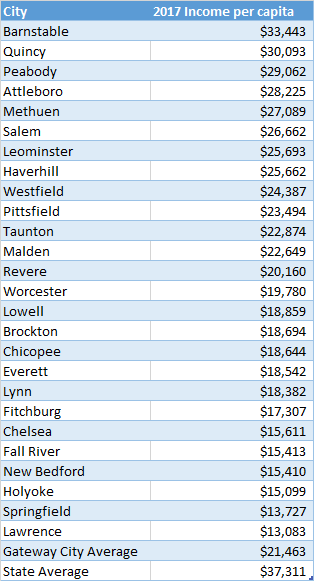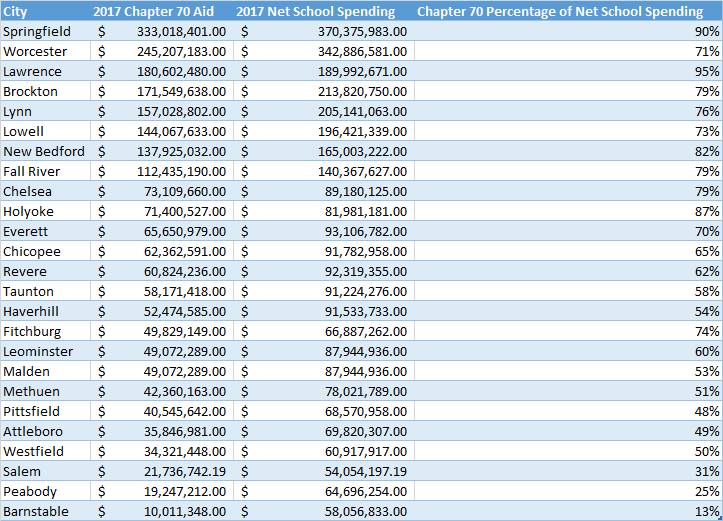Income and Education Levels in Gateway Cities Well Below State Average as Debate over Chapter 70 Aid Formula Heats Up
Data from Pioneer’s online transparency toolset, MassAnalysis.com, shows that the Gateway Cities have some of the lowest per-capita incomes in the Commonwealth, according to the most recent data from 2017. Education and income levels are intrinsically tied, and not surprisingly, high school graduation rates in the Gateway Cities lag well behind the rest of the state.
As shown in the table below, Barnstable, Quincy, Peabody, Attleboro, and Methuen are the only Gateway Cities that do not rank in the bottom third of the 351 municipalities in Massachusetts in per capita income for 2017. Lawrence had the fifth lowest in the state, while Springfield and New Bedford had the eighth and tenth lowest, respectively. The average per capita income in the top third of Massachusetts municipalities was $63,457 and $32,017 in the middle third. In comparison the average per capita income among Gateway Cities was just $21,463, far less than the state average of $37,311.

Data from the Massachusetts Department of Elementary and Secondary Education (DESE) shows that the average high school graduation rate in the Gateway Cities in 2017 was 79.7 percent, well below the state average of 88.3 percent. Chelsea and New Bedford had the 7th and 8th lowest graduation rates in the state at 57 percent and 59 percent, respectively.
This brings us to the question of whether the Commonwealth should be doing more to help address the income and education gap between the Gateway Cities and the rest of the state, specifically by increasing Chapter 70 aid.
Chapter 70, which provides state funding for public elementary and secondary schools, as well as setting minimum spending requirements for each school district and their share of school costs, is by far the largest local aid program. Gateway Cities already make up 23 of the top 25 municipalities in terms of Chapter 70 aid. However, the Massachusetts State Senate is considering a bill to update and revise the state’s education funding formula, which asserts that more funds need to be allocated to account for rising healthcare costs and additional resources for special needs students. Gateway Cities Brockton and Worcester are also considering legal action, alleging that the funding methodology leaves them ill-equipped to deal with the challenges of their school populations.
As shown in the table below, Chapter 70 aid made up more than 50 percent of net school spending for all but three Gateway Cities in 2017:

The Chapter 70 funding formula is intended to determine what adequate and equitable spending levels are for each district in order for students to be proficient. A separate aggregate wealth formula is used to determine the definition of equitable.
However, there may never be true parity. Even though the Commonwealth grants Gateway Cities the highest foundation budgets because their student populations need the most funding, wealthier municipalities still end up spending more per pupil because their residents can afford to pay higher taxes to fund their school districts.
As Pioneer’s Tom Birmingham pointed out in a recent op-ed, a lack of funding is far from the only issue facing our schools. For the Gateway Cities however, revisiting the conversation around Chapter 70 aid is critical at this juncture, as costs and enrollment levels continue to rise.
For more analysis of Massachusetts communities, visit MassAnalysis.com, where you can use our tools to benchmark how your city or town is doing across a number of different measures.



